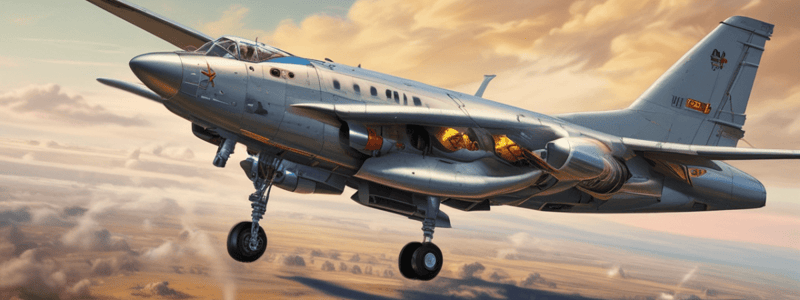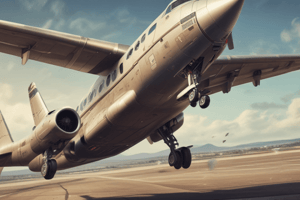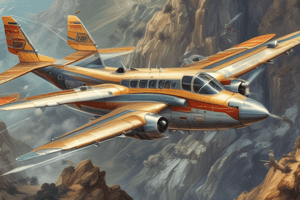Podcast
Questions and Answers
What is the primary purpose of the empennage?
What is the primary purpose of the empennage?
- To generate lift
- To house the main landing gear
- To provide stability and control (correct)
- To support the aircraft during landing
Which component is designed to withstand various stresses while providing a streamlined shape to minimize aerodynamic drag?
Which component is designed to withstand various stresses while providing a streamlined shape to minimize aerodynamic drag?
- Wings
- Empennage
- Landing gear
- Fuselage (correct)
What is a key factor in determining the shape and size of an aircraft's wings?
What is a key factor in determining the shape and size of an aircraft's wings?
- Intended use of the aircraft (correct)
- Aircraft speed
- Aircraft size
- Type of landing gear
What is the purpose of shock-absorbing components in the landing gear?
What is the purpose of shock-absorbing components in the landing gear?
What is the term for the attachment point for other major components such as wings, empennage, and, in some cases, engines?
What is the term for the attachment point for other major components such as wings, empennage, and, in some cases, engines?
What is the primary function of an aircraft's powerplant?
What is the primary function of an aircraft's powerplant?
Which of the following is NOT a type of engine system that provides thrust for an aircraft?
Which of the following is NOT a type of engine system that provides thrust for an aircraft?
What is the result of the combined efforts of an aircraft's engines and wings?
What is the result of the combined efforts of an aircraft's engines and wings?
What is the primary role of the fuselage in an aircraft?
What is the primary role of the fuselage in an aircraft?
What is the critical understanding that pilots must have to operate and troubleshoot an aircraft effectively?
What is the critical understanding that pilots must have to operate and troubleshoot an aircraft effectively?
The primary function of an aircraft's engine is to convert mechanical power into fuel.
The primary function of an aircraft's engine is to convert mechanical power into fuel.
The empennage is responsible for producing lift during flight.
The empennage is responsible for producing lift during flight.
The design of the fuselage has no impact on an aircraft's aerodynamics.
The design of the fuselage has no impact on an aircraft's aerodynamics.
Pilots do not need to have a solid understanding of an aircraft's components to operate safely.
Pilots do not need to have a solid understanding of an aircraft's components to operate safely.
The landing gear is only responsible for taking off from solid ground.
The landing gear is only responsible for taking off from solid ground.
The empennage is located at the front of the aircraft.
The empennage is located at the front of the aircraft.
The landing gear is always fixed and cannot be retracted during flight.
The landing gear is always fixed and cannot be retracted during flight.
The powerplant is responsible for generating lift for the aircraft.
The powerplant is responsible for generating lift for the aircraft.
The fuselage is only responsible for housing the cockpit and passenger compartment.
The fuselage is only responsible for housing the cockpit and passenger compartment.
The wings of an aircraft are always identical in shape and size.
The wings of an aircraft are always identical in shape and size.
How does the design of the fuselage contribute to the overall aerodynamics of an aircraft?
How does the design of the fuselage contribute to the overall aerodynamics of an aircraft?
What role do the wings play in determining an aircraft's speed, payload capacity, and fuel efficiency?
What role do the wings play in determining an aircraft's speed, payload capacity, and fuel efficiency?
How do the empennage and its components contribute to an aircraft's stability and direction?
How do the empennage and its components contribute to an aircraft's stability and direction?
What are the primary functions of the landing gear, and how do its different configurations accommodate various operational environments?
What are the primary functions of the landing gear, and how do its different configurations accommodate various operational environments?
How do the components of an aircraft, including the fuselage, wings, empennage, powerplant, and landing gear, work together to enable safe and efficient flight?
How do the components of an aircraft, including the fuselage, wings, empennage, powerplant, and landing gear, work together to enable safe and efficient flight?
What is the significance of the interdependence of an aircraft's components in ensuring its safe and efficient operation?
What is the significance of the interdependence of an aircraft's components in ensuring its safe and efficient operation?
How does the powerplant contribute to the overall performance of an aircraft, and what would be the consequences of its failure?
How does the powerplant contribute to the overall performance of an aircraft, and what would be the consequences of its failure?
What is the relationship between the thrust produced by the engines and the lift produced by the wings, and how do they work together to enable flight?
What is the relationship between the thrust produced by the engines and the lift produced by the wings, and how do they work together to enable flight?
What role does the fuselage play in an aircraft's aerodynamics, and how does its design impact the overall performance of the aircraft?
What role does the fuselage play in an aircraft's aerodynamics, and how does its design impact the overall performance of the aircraft?
What is the importance of pilots having a solid understanding of an aircraft's components and their functions, and how does this impact their ability to operate and troubleshoot the aircraft?
What is the importance of pilots having a solid understanding of an aircraft's components and their functions, and how does this impact their ability to operate and troubleshoot the aircraft?
Flashcards are hidden until you start studying
Study Notes
Aircraft Components
- An aircraft is a system of interconnected components, regardless of size or complexity.
- The primary components of an aircraft are the fuselage, wings, empennage, powerplant, and landing gear.
Fuselage
- The fuselage is the main body of the aircraft, housing the cockpit, cargo area, and passenger compartment.
- It is designed to withstand various stresses while providing a streamlined shape to minimize aerodynamic drag.
- The fuselage serves as the attachment point for other major components such as wings, empennage, and, in some cases, engines.
Wings
- Wings are airfoil-shaped structures extending on either side of the fuselage and are critical for generating lift.
- The shape and size of the wings are tailored to the aircraft's intended use, influencing its speed, payload capacity, and fuel efficiency.
- Wings may also contain fuel tanks and house the main landing gear in retractable configurations.
Empennage
- The empennage is the tail section of the aircraft, consisting of vertical and horizontal stabilizers alongside controls such as the elevator and rudder.
- These controls are not just for control but also for maintaining the aircraft's direction and altitude.
Landing Gear
- The landing gear supports the aircraft during takeoff, landing, and ground operations.
- There are different landing gear configurations, such as tricycle, tail-dragger, floats, and skis, each suited to specific operational environments.
- The gear includes shock-absorbing components to cushion the impact of landing and may be fixed or retractable to reduce drag during flight.
Powerplant
- The powerplant is the heart of an aircraft, encompassing the engine systems that provide the thrust necessary for flight.
- Each type of engine plays a significant role in aircraft performance, from piston engines to turbofans, with specific engines suited to different flight conditions.
- The engine's primary function is to convert fuel into mechanical power, which propels the aircraft forward, driving the propellers or powering the jet turbines.
Aircraft Components
- An aircraft is a system of interconnected components, regardless of size or complexity.
- The primary components of an aircraft are the fuselage, wings, empennage, powerplant, and landing gear.
Fuselage
- The fuselage is the main body of the aircraft, housing the cockpit, cargo area, and passenger compartment.
- It is designed to withstand various stresses while providing a streamlined shape to minimize aerodynamic drag.
- The fuselage serves as the attachment point for other major components such as wings, empennage, and, in some cases, engines.
Wings
- Wings are airfoil-shaped structures extending on either side of the fuselage and are critical for generating lift.
- The shape and size of the wings are tailored to the aircraft's intended use, influencing its speed, payload capacity, and fuel efficiency.
- Wings may also contain fuel tanks and house the main landing gear in retractable configurations.
Empennage
- The empennage is the tail section of the aircraft, consisting of vertical and horizontal stabilizers alongside controls such as the elevator and rudder.
- These controls are not just for control but also for maintaining the aircraft's direction and altitude.
Landing Gear
- The landing gear supports the aircraft during takeoff, landing, and ground operations.
- There are different landing gear configurations, such as tricycle, tail-dragger, floats, and skis, each suited to specific operational environments.
- The gear includes shock-absorbing components to cushion the impact of landing and may be fixed or retractable to reduce drag during flight.
Powerplant
- The powerplant is the heart of an aircraft, encompassing the engine systems that provide the thrust necessary for flight.
- Each type of engine plays a significant role in aircraft performance, from piston engines to turbofans, with specific engines suited to different flight conditions.
- The engine's primary function is to convert fuel into mechanical power, which propels the aircraft forward, driving the propellers or powering the jet turbines.
Aircraft Components
- An aircraft is a system of interconnected components, regardless of size or complexity.
- The primary components of an aircraft are the fuselage, wings, empennage, powerplant, and landing gear.
Fuselage
- The fuselage is the main body of the aircraft, housing the cockpit, cargo area, and passenger compartment.
- It is designed to withstand various stresses while providing a streamlined shape to minimize aerodynamic drag.
- The fuselage serves as the attachment point for other major components such as wings, empennage, and, in some cases, engines.
Wings
- Wings are airfoil-shaped structures extending on either side of the fuselage and are critical for generating lift.
- The shape and size of the wings are tailored to the aircraft's intended use, influencing its speed, payload capacity, and fuel efficiency.
- Wings may also contain fuel tanks and house the main landing gear in retractable configurations.
Empennage
- The empennage is the tail section of the aircraft, consisting of vertical and horizontal stabilizers alongside controls such as the elevator and rudder.
- These controls are not just for control but also for maintaining the aircraft's direction and altitude.
Landing Gear
- The landing gear supports the aircraft during takeoff, landing, and ground operations.
- There are different landing gear configurations, such as tricycle, tail-dragger, floats, and skis, each suited to specific operational environments.
- The gear includes shock-absorbing components to cushion the impact of landing and may be fixed or retractable to reduce drag during flight.
Powerplant
- The powerplant is the heart of an aircraft, encompassing the engine systems that provide the thrust necessary for flight.
- Each type of engine plays a significant role in aircraft performance, from piston engines to turbofans, with specific engines suited to different flight conditions.
- The engine's primary function is to convert fuel into mechanical power, which propels the aircraft forward, driving the propellers or powering the jet turbines.
Studying That Suits You
Use AI to generate personalized quizzes and flashcards to suit your learning preferences.




